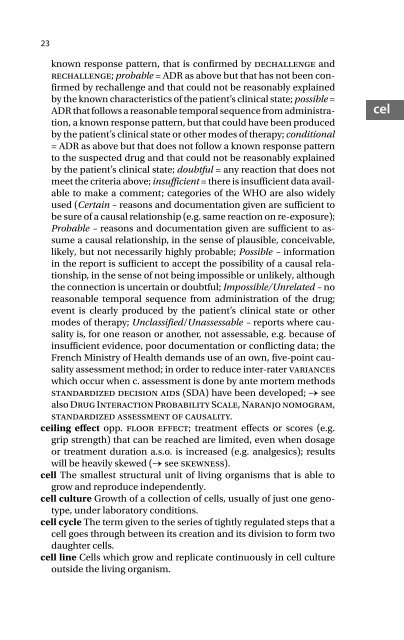220-Dictionary of Pharmaceutical Medicine, 2nd Edition-Gerhard Nahler Annette Mollet-3211898352-S
220-Dictionary of Pharmaceutical Medicine, 2nd Edition-Gerhard Nahler Annette Mollet-3211898352-S
220-Dictionary of Pharmaceutical Medicine, 2nd Edition-Gerhard Nahler Annette Mollet-3211898352-S
You also want an ePaper? Increase the reach of your titles
YUMPU automatically turns print PDFs into web optimized ePapers that Google loves.
23known response pattern, that is confirmed by dechallenge andrechallenge; probable = ADR as above but that has not been confirmedby rechallenge and that could not be reasonably explainedby the known characteristics <strong>of</strong> the patient’s clinical state; possible =ADR that follows a reasonable temporal sequence from administration,a known response pattern, but that could have been producedby the patient’s clinical state or other modes <strong>of</strong> therapy; conditional= ADR as above but that does not follow a known response patternto the suspected drug and that could not be reasonably explainedby the patient’s clinical state; doubtful = any reaction that does notmeet the criteria above; insufficient = there is insufficient data availableto make a comment; categories <strong>of</strong> the WHO are also widelyused (Certain – reasons and documentation given are sufficient tobe sure <strong>of</strong> a causal relationship (e.g. same reaction on re-exposure);Probable – reasons and documentation given are sufficient to assumea causal relationship, in the sense <strong>of</strong> plausible, conceivable,likely, but not necessarily highly probable; Possible – informationin the report is sufficient to accept the possibility <strong>of</strong> a causal relationship,in the sense <strong>of</strong> not being impossible or unlikely, althoughthe connection is uncertain or doubtful; Impossible/Unrelated – noreasonable temporal sequence from administration <strong>of</strong> the drug;event is clearly produced by the patient’s clinical state or othermodes <strong>of</strong> therapy; Unclassified/Unassessable – reports where causalityis, for one reason or another, not assessable, e.g. because <strong>of</strong>insufficient evidence, poor documentation or conflicting data; theFrench Ministry <strong>of</strong> Health demands use <strong>of</strong> an own, five-point causalityassessment method; in order to reduce inter-rater varianceswhich occur when c. assessment is done by ante mortem methodsstandardized decision aids (SDA) have been developed; → seealso Drug Interaction Probability Scale, Naranjo nomogram,standardized assessment <strong>of</strong> causality.ceiling effect opp. floor effect; treatment effects or scores (e.g.grip strength) that can be reached are limited, even when dosageor treatment duration a.s.o. is increased (e.g. analgesics); resultswill be heavily skewed (→ see skewness).cell The smallest structural unit <strong>of</strong> living organisms that is able togrow and reproduce independently.cell culture Growth <strong>of</strong> a collection <strong>of</strong> cells, usually <strong>of</strong> just one genotype,under laboratory conditions.cell cycle The term given to the series <strong>of</strong> tightly regulated steps that acell goes through between its creation and its division to form twodaughter cells.cell line Cells which grow and replicate continuously in cell cultureoutside the living organism.cel


